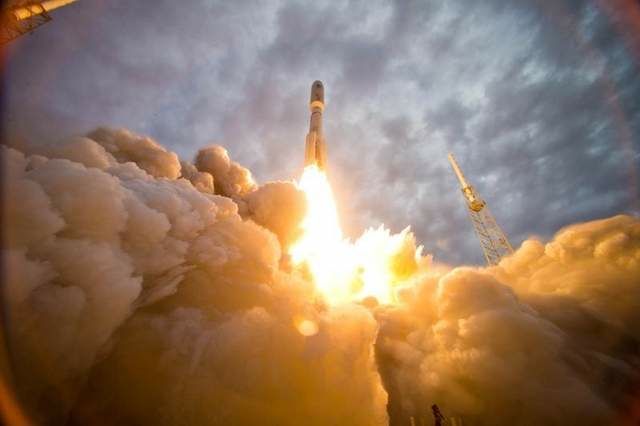Aerospace Combat Command Instead of Space Force?
Posted on

Over the past two years, America’s near-peer competitors have reorganized and integrated their air, deterrent, missile defense, cyber and space forces to make them more effective.
But U.S. competitors aren’t just reorganizing; they are building and fielding capabilities that create new vulnerabilities for the U.S. in space. As Gen. Jay Raymond, head of Air Force Space Command said in recent testimony: “In the not too distant future, near-peer competitors will have the ability to hold every U.S. space asset in every orbital regime at risk.”
 Dissatisfied with the speed of the Air Force’s response to these challenges, House Armed Services strategic forces subcommittee Chair Mike Rogers and Ranking Member Jim Cooper have proposed (and the full House has adopted) a semi-independent Space Force within the Air Force Department in the House version of the fiscal 2018 National Defense Authorization Act.
Dissatisfied with the speed of the Air Force’s response to these challenges, House Armed Services strategic forces subcommittee Chair Mike Rogers and Ranking Member Jim Cooper have proposed (and the full House has adopted) a semi-independent Space Force within the Air Force Department in the House version of the fiscal 2018 National Defense Authorization Act.
In a joint statement, Chairman Rogers and Rep. Cooper say: “There is bipartisan acknowledgement that the strategic advantages we derive from our national security space systems are eroding… We are convinced that the Department of Defense is unable to take the measures necessary to address these challenges effectively and decisively, or even recognize the nature and scale of its problems.”
Congressional frustration with the Air Force is understandable. After years of Air Force underinvestment in the basics of access to space, the United States depends on Russian engines to get national security satellites into space. To make matters worse, U.S. satellites often run into technical challenges and cost overruns that delay them for years. And when they finally arrive in orbit, they are increasingly vulnerable.

Russian-made RD-180 engines propel an Atlas V rocket heavenward.
In addition, after years of failed investment in reusable launch systems designed to lower the cost of access to space, the Air Force left it to the private sector to solve the challenges of inventing a practical, reusable first stage.
But the best response to today’s challenges may not be the creation of a separate — and weaker — Space Corps, one carved out of a diminished Air Force and authorized by statute to focus mainly on making space safe for satellites.
History suggests that integrated operations and unity of command are much better than stovepiping in successful military operations.
Instead of a separate Space Corps, Congress and the Trump Administration should consider an integrated “United States Aerospace Force” – with new capabilities derived from American industry – allowing it to affordably and routinely cross the boundary between air and space.
Industry’s recent success with the launch, landing and reuse of Mach 3 to Mach 10 rocket vehicles indicates it can provide this capability, given the right focus from national leadership.
With reusable launch vehicles and higher flight rates driving the cost of access to space down, an Aerospace Force would have far less incentive to raid space accounts to buy air platforms, addressing Chairman Rogers’ concern that the Air Force’s current organization “force[s] space to compete with F-35s.”
 This would not be the first time the US military has needed help from the private sector. In the early 1930s, Boeing “leapfrogged” the capabilities of contemporary Army Air Corps aircraft when it introduced new aerodynamic and technical features into commercial airliners for the first time in the Boeing 247 — with its all-metal flush-rivet semi-monocoque construction, fully cantilevered wing, and retractable landing gear.
This would not be the first time the US military has needed help from the private sector. In the early 1930s, Boeing “leapfrogged” the capabilities of contemporary Army Air Corps aircraft when it introduced new aerodynamic and technical features into commercial airliners for the first time in the Boeing 247 — with its all-metal flush-rivet semi-monocoque construction, fully cantilevered wing, and retractable landing gear.
These technologies were developed for commercial reasons – not in answer to military requirements – but after the Air Corps’ poor performance in the Air Mail crisis and the Baker Board’s recommendations to the Corps in 1934, the War Department leveraged these commercial advances directly into warfighting capability through the acquisition of aircraft such as the Boeing 299 (B-17 bomber), the DC-2 (B-18 bomber) and the DC-3 (C-47 military transport).
These aircraft, whose basic technologies were developed by industry for the purpose of transporting civilians safely and profitably, became the backbone of military and civilian aviation through World War II and beyond.
This can be done again today, by
- combining Space Command and Air Combat Command into an integrated “Aerospace Combat Command” and
- leveraging new, lower cost reusable rockets now flying (or on the near horizon) from private sector companies such as SpaceX, Blue Origin and others.
A revitalized United States Aerospace Force could:
- launch into space on American engines; increase launch rates to provide resilient capability in case of conflict;
- conduct traditional Air Force mobility and strike missions through space;
- and make the Air Force much more effective at deterring and defeating threats in space—in the air—and on the surface.
This would require bold vision and leadership from the Air Force, comparable to the leadership shown by its leaders at the service’s birth. The Air Force has shown that it can rise to any challenge — from the Berlin Airlift forward to the Persian Gulf — especially with the right encouragement and leadership from the Congress and the White House.
Bill Bruner, a former NASA assistant administrator and fellow in the Speaker’s Office under Newt Gingrich, is CEO of New Frontier Aerospace, a space technology development and consulting company. He is a retired Air Force colonel.
Subscribe to our newsletter
Promotions, new products and sales. Directly to your inbox.
